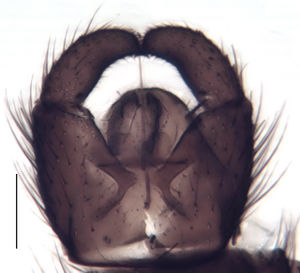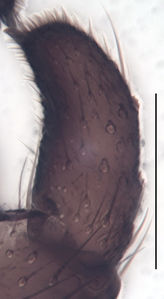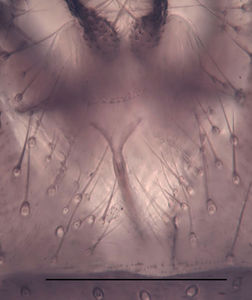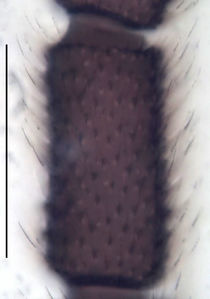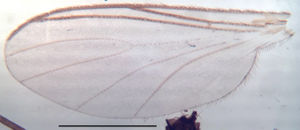Trichosiopsis extra
Ordo: Diptera
Familia: Sciaridae
Genus: Trichosiopsis
Name
Trichosiopsis extra unpublished
Type material
Holotype: ♂, 16.5.–2.6.2014, Malaise trap, leg. Rulik et al., ZFMK-TIS-2564676 in ZFMK
Type locality
Germany, Rhineland-Palatinate, Niederzissen, Bausenberg
Barcoded material
| Stadium | Country | Province | Locality | Habitat | Method | Date | Collector | Collection Number | Collection | Latitude | Longitude | Elevation (m) |
|---|---|---|---|---|---|---|---|---|---|---|---|---|
| 1 ♂ (holotype) | Germany | Rhineland-Palatinate | Niederzissen, Bausenberg | Trockenrasen | Malaise trap | 16.5.–2.6.2014 | Rulik et al. | ZFMK-TIS-2564676 | ZFMK | 50.465 | 7.222 | 321 |
| 1 ♀ | Norway | Sør-Trøndelag | Trondheim, Sommerlystvegen 22 | Malaise trap | 1.6.–8.6.2014 | Elisabeth Stur; Torbjørn Ekrem | BIOUG15675-F06 | NTNU | 63.405 | 10.383 | 65 | |
| 1 | Germany | Rhineland-Palatinate | Mayen-Koblenz | Forest | Malaise trap | 2.5.–16.5.2013 | Rulik et al. | BIOUG22302-B07 | ZFMK | 50.32 | 7.493 | 243 |
| 1 | Germany | Baden-Württemberg | Tübingen | Malaise trap | 13.5.–23.5.2014 | T. Kothe; M. Engelhardt & Ch. Koenig | BIOUG26145-D09 | ZFMK | 48.531 | 9.031 | 476 | |
| 1 ♂ | Germany | Rhineland-Palatinate | Niederzissen, Bausenberg | Wiese | Malaise trap | 16.5.–2.6.2014 | Rulik et al. | ZFMK-TIS-2559678 | ZFMK | 50.465 | 7.226 | 292 |
| 1 ♂ | Germany | Rhineland-Palatinate | Niederzissen, Bausenberg | Trockenrasen | Malaise trap | 16.5.–2.6.2014 | Rulik et al. | ZFMK-TIS-2564644 | ZFMK | 50.465 | 7.222 | 321 |
| 1 ♂ | Germany | Rhineland-Palatinate | Winningen | Wald | Malaise trap | 18.4.–2.5.2013 | Rulik et al. | ZFMK-TIS-2564687 | ZFMK | 50.32 | 7.493 | 248 |
Other material studied
Germany: 1 ♂, North-Rhine-Westphalia, Köln-Poll, Garten, Malaise trap, Franzen, 12.-19.09.1989, PKHH 1325; 1 ♂, Schleswig-Holstein, Schierensee, Oberer Schierenseebach, emergence trap, Buske, 25.05.1991, PKHH 7.
Description (male)
Head. Eye bridge 5–6 rows of facets. Antenna unicolour. LW-index of 4th flagellomere 1.9–2.1; neck 0.21–0.29 × segment width; transition of basal part to neck pronounced. Colour of neck unicolour. Antennal setae shorter than segment width; fine; dense; salient. Palpus darkened; of normal length, or long; palpomeres 3. First palpomere elongate; with 5–8 setae; with only sparse sensilla. Second palpomere elongate. Third palpomere as long as first. Thorax. Colour brown. Notum unicolour. Thoracic setae long and strong; of different colours. Posterior pronotum setose. Postpronotal setae 3–6; fine. Mesothoracic sclerites bare. Legs. Colour yellow. Hind coxa darkened. Setae on front coxa pale. Front tibial organ as patch of setae; pale; front tibial organ not bordered. Tibial setae on hind legs normal, shorter than tibial width. Tibial spurs of equal length. Claws untoothed. Wing. Wing hyaline; with conspicuous anal lobe, or of normal shape. Wing membrane without macrotrichia. Wing venation weak, with faint stM. M-fork of normal shape. R1 ending at or slightly before base of m-fork; posterior veins with macrotrichia; stM mostly with macrotrichia; CuA1 and CuA2 mostly with macrotrichia; bM setose; r-m mostly setose; bM:r-M 0.75–0.9; st-Cu:bM 0.15–0.3; R1:R 1.25–1.5; c:w 0.65–0.75. Halter darkened; of normal length. Abdomen. Abdominal setae strong; dense; on tergites dark and pale; on sternites white. Hypopygium concolour with abdomen; LW-index 0.65–0.8. Base of gonocoxites with weak setae; gonocoxites broadly separated; inner margin of gonocoxites typically U-shaped; inner membrane of hypopygium bare; ventral margin of gonocoxite with short setae. Gonostylus elongate; LW-index 2.45–2.7; Inner margin concave; apex equally rounded. Apical tooth present; without internal structure; of medium strength. Awl-like setae normal; present beneath apical tooth. Megasetae absent. Whiplash-hair absent. Tegmen 0.5–0.65 × longer than broad; rectangular with rounded edges; without special features; central process absent. Length of ejaculatory apodeme/hypopygium 22–32 %; base of ejaculatory apodeme present. Field with aedeagal teeth inconspicuous. Measurements. Body size 2.7–3.5 mm. Hind tibia 1.45–1.65 mm. Wing length 2.8–3.5 mm.
Diagnosis
Tr. extra belongs to the Trichosiopsis trochanterata complex, characterized by an elongate, tapered gonostylus and partly bright body hairs. It is similar to Tr. trochanterata by the yellow legs. However, the setae at the hind tibia are not so conspicuous as in Tr. trochanterata, mid and hind coxae are darkened and the wing is more hyaline. The gonostylus is less elongate and the species is smaller.
DNA Barcoding
The COI sequence is assigned to BIN BOLD:ACP8774 (average distance 0.19%, max. 0.52%, n=7, K2P: 9.98%).
Etymology
The species for its name for being still one more in this uniform species complex.
Discussion
Trichosiopsis extra is another species, which was or would have been regarded as belonging to a very variable species Tr. trochanterata. However, the constant differences in colour and the huge genetic distance of nearly 10% prove its distinctness. The BIN appeared first on BOLD from a female specimen, which was sampled during a mass Malaise trap sampling in Trondheim and could not be identified at that time. Only later genetically corresponding males from Germany made it possible to identify the Norwegian female.
Distribution
Germany, Norway.
Images
|

